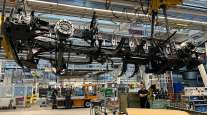Senior Reporter
Daimler Q3 Net Income Rises Slightly, Revenue Dips

[Stay on top of transportation news: Get TTNews in your inbox.]
Daimler AG reported modestly higher net income and a dip in revenue in the third quarter as truck sales rose, but sales of Mercedes-Benz vehicles plunged.
“We made substantial progress with our strategic agenda,” Daimler Chief Financial Officer Harald Wilhelm said in a release.
That included, he said, “continuing the rollout of highly desirable electric vehicles, laying the groundwork for scaled up battery cell production with our intended stake in ACC [European battery cell manufacturer Automotive Cells Co.] and through gaining shareholder approval for creating two pure-play companies.”
We just released our Q3 figures. — Daimler Truck AG (@DaimlerTruck) October 29, 2021
Daimler AG announced the most major reorganization in the company’s history Feb. 3. Under the plan, Daimler AG would in February rename itself Mercedes-Benz Group, and the truck and bus unit would become Daimler Truck AG by the end of the year. Like the truck unit, the car and van business would be individually traded.
Net income for the period ended Sept. 30, reported in euros, was the equivalent of $2.8 billion, or $2.67 per share, on revenue of $46.2 billion.
That compared with net income of $2.4 billion, or $2.21, on revenue of $46.4 billion, a year earlier.
The company has lowered fixed costs by about 15% compared with 2019 as part of a plan announced a year ago to pare spending over the first half of the decade, Bloomberg News reported.
The quarter saw total vehicle sales fall to 577,848 compared with 772,703 in the 2020 period.
Truck sales increased 8% to 101,715 compared with 94,141 a year earlier, according to the Stuttgart, Germany-based company, which is the world’s leading commercial vehicle manufacturer based on revenue.
Headwinds from raw materials were partially offset through increased net pricing, the company reported. Its 2022 order book for trucks in North America shows record incoming orders.
Daimler noted major truck markets are expected to recover this year, with increased sales in North America, Indonesia and the European Union region.

In this episode, host Michael Freeze asks, how are companies saving money by leasing trucks rather than owning? For answers, we speak with Jim Lager of Penske Truck Leasing and Al Barner of strategic fleet solutions at Fleet Advantage. Hear a snippet above, and get the full program by going to RoadSigns.TTNews.com.
Supply shortages of semiconductors had a major impact on its North American and European heavy-truck business, Jochen Goetz, executive vice president of finance at Daimler Trucks, said Oct. 29 during the earning call.
“However, we have done everything to finish vehicles as far as possible so we can deliver our trucks and buses to customers in the next weeks and months,” Goetz said. “The demand is still very strong — significantly stronger than what the supply side allows for production capacity, at the moment. We had a very solid September, but visibility is still low and just might remain so for the rest of the year.”
Among recent highlights in the truck segment, in September Daimler Trucks North America introduced its Western Star brand’s 47X vocational model — a Class 8 truck intended for lighter-weight applications than the heavier 49X introduced in September 2020.
The 47X is expected to replace Western Star’s existing 4700 series vocational trucks within the next two or three years, Daimler Trucks North America reported at the launch.

Daimler Chairman Ola Källenius. (Daimler AG)
Bus sales fell to 4,729 compared with 5,115 a year earlier.
Revenue at the truck and bus unit slipped to $10.1 billion compared with $10.6 billion in the 2020 period. The unit earned a 5.4% return on sales compared with 5.9% a year earlier.
Sales at Mercedes-Benz cars and vans, its largest unit, fell to 471,404 compared with 673,447 a year earlier.
Revenue dipped to $29.5 billion compared with $29.8 billion a year earlier. The unit earned a 7.8% return on sales compared with 8.2% in the 2020 period.
Sales of Mercedes-Benz cars declined 32% to 383,500 vehicles in the third quarter compared with a year earlier.
High-end vehicles including Mercedes-Maybach, Mercedes-AMG, the S-Class and G-Class as well as the GLE and GLS showed strong growth, with favorable mix and net pricing helping to partially offset semiconductor-driven supply constraints and raw material headwinds.
At Daimler Mobility, its unit focused on financing and mobility services, revenue was flat at $7.8 billion compared with a year earlier.
The company’s challenges have been little cause for concern among investors who have been encouraged by Daimler CEO Ola Kallenius’ emphasis on value over volume. Daimler shares rose as much as 2.3% on Oct. 29 in Frankfurt and are up 48% this year, Bloomberg noted.
Want more news? Listen to today's daily briefing below or go here for more info:




